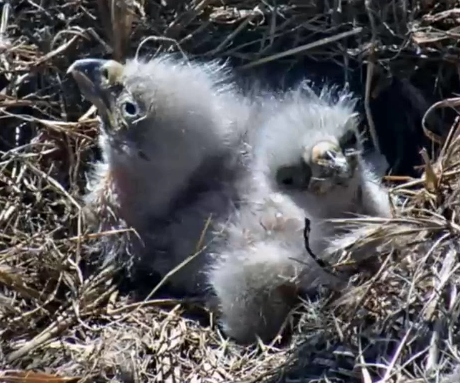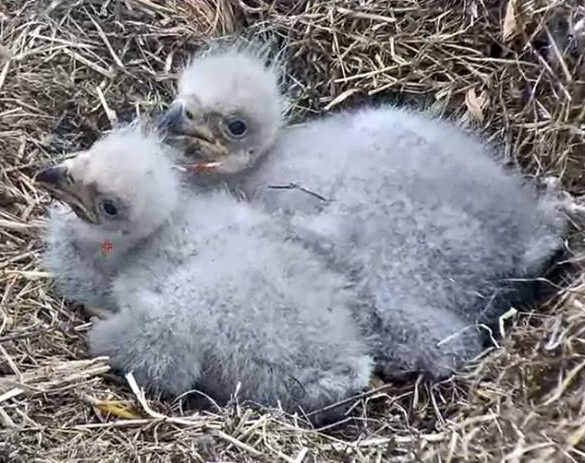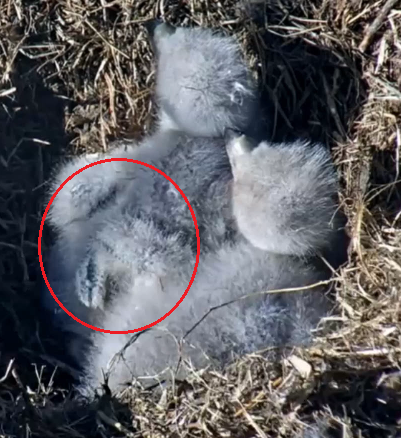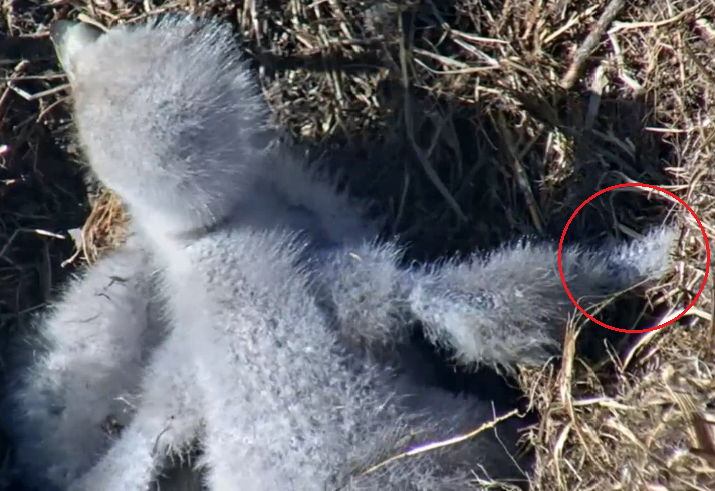© elfruler 2018
“intraspecific adj. : occurring within a species or involving members of one species.” (www.merriam-webster.com)
Bald Eagles choose their breeding territories and nest sites carefully, driven by factors that will lead to success in raising their young. These factors include adequate food resources, a sturdy nest platform, available shelter from dangerous weather, ease of defense, and tolerable distance from disturbances. A good location will be attractive to any Bald Eagles that come along, and it is not surprising that a resident Bald Eagle pair will be challenged by other Bald Eagles for the site, leading to competition between members of the species, or intraspecific conflict.
It is not uncommon for one or both members of a pair to be challenged even before the nesting season begins, resulting in displacement, injury, and even death. Conflicts that occur once a clutch of eggs has been laid or a brood of chicks has hatched can cause loss of eggs and chicks, despite the fierce defense that the parents inevitably mount against intruders. Often the parents are successful in repelling a challenge and their chicks fledge. In rare cases an intruder is accepted by the resident pair as a cooperative breeder (Go here for a series of pages about Cooperative Breeding and its occurrence among Bald Eagles).
The Bald Eagle nests that have been viewed on camera or monitored carefully from the ground since 1992 have provided a glimpse of intraspecific intrusions of many types and with a variety of outcomes:
- Events before, during, and after the season
- From one to many intruders
- Intruding males and females, adults, subadults, and juveniles
- Replacements, disappearances, injuries, and deaths of parents
- Unhatched or broken eggs and injured or slain nestlings
- Double clutches
- Rescued nestlings and rehabbed fledglings
- Successful fledges
- Cooperative breeding
Even careful monitoring of cams and nests don’t provide the full picture of events surrounding intrusions, which often take place out of human view. Even happenings in full view do not always have clear-cut explanations.
- How many intruders are in the area?
- When did they first appear?
- What encounters occur off-nest between intruders and residents?
- What is the sex or age of an intruder?
- Does a resident eagle disappear because it has been injured or killed, or because it has decided that it cannot prevail in a battle?
- Was an egg broken by an intruder or an agitated parent, or because it was unviable or infertile?
- Did an egg fail to hatch because intruders interrupted the reproductive cycle and prevented fertilization?
- Why would one intruder destroy eggs or chicks but another intruder leave eggs or chicks undamaged?
- Does a resident adult respond primarily defensively to an intruder, or might there be a trigger that precipitates an offensive response?
- Why would an intruder become a helper and cooperative breeder rather than a threat?
Answers to such questions would provide a much better understanding of events we can see, but too often the answers elude us.
The number of Bald Eagle nests for which reliable daily reports have been made more than doubled from 2008 to 2018 – from 24 to 57. They range from southern California to New England, from south Florida to Alaska, and many points on the continent inbetween. The nests are found in a variety of habitats, including rural farmland, along rivers and streams, lakes and bays, in woodlands in parks and wildlife refuges, on coastal islands, college campuses, and in city neighborhoods. Yet it cannot be claimed that these nests are a representative sampling of all of the thousands of Bald Eagle nests in North America.
Nor can we be sure that we have witnessed every conceivable behavior or outcome associated with intraspecific intrusions. The information that I present here is illustrative of certain types of Bald Eagle behavior, but should not be taken as a statistical report on intraspecific intrusions.
This first chart (at this link) describes the intraspecific intrusions observed at Bald Eagle nests from 1992 through 2018, the nest locations and habitats, what is known about the intruders, the events, and the outcomes. (Link opens in a new browser tab.) Losses (of parents, eggs, or chicks) can result directly or indirectly from intrusions, or they may occur for other reasons not related to intraspecific conflict. Not every intrusion leads to a loss.
This second chart (follow this link) summarizes the details and gives percentages to enable comparison of intrusions, losses, and fledges from one year to the next. (Link opens in a new browser tab.) The percentages are number of intrusion events (nest intrusions, clutch intrusions, eggs lost, etc.) compared to the total number observed (nests, clutches, eggs., etc.) in that season. (The years 1992-2007 at the California West End nest are not included in this summary because of the outsized effect of DDE contamination on egg production there.) Notably, for these nests there is no clear trend in the percentages over time.
- While 2018 clearly was a bad year for nest intrusions (including both before and during a clutch), at 24.6% of observed nests, 2008 was almost as bad, at 20.8% of observed nests.
- On the other hand, 2008 was a worse year for clutch intrusions (after eggs were laid), at 19.2% compared to 17.9% in 2018.
- And in 2008, 4.5% of chicks were lost, compared to a much smaller 1.3% in 2018.
- The number of eggs lost was a staggering 11.3% in 2018, but the 8.6% of eggs lost in 2008 is the second highest percentage.
- The year 2013 was difficult, with 13.6% of clutch intrusions and 6.7% of egg losses.
- Some years were relatively benign: 2011 saw only one intrusion and 2012 only two. A dip in losses occurred in 2015 and in intrusions in 2016.
- From 2013-2017 most percentages were relatively stable – nest intrusions, clutch intrusions, losses – with an overall dip in 2016. Intrusions and losses in 2018 were severe, and it remains to be seen in coming seasons whether that year was an outlier.
BRIEF UPDATE ON THE 2018-2019 SEASON: I have not yet added new information to the charts, but the number of intraspecific intrusions declined significantly from the year before. Only 6 such intrusions occurred, only 2 of which happened after eggs were laid. 2 nests ended up with no eggs laid, and a total of 4 eggs were lost. No eaglets were lost.
There is no question that suitable habitat for nesting Bald Eagles is on the decline across the continent because of human development and encroachment. But the numbers we have for these particular nests do not necessarily mean that increasing numbers of nest intrusions point to an approaching saturation of carrying capacity for Bald Eagles across the board. Each territory has its own conditions that may or may not be either conducive or resistant to nest intrusions. Increasing population density in a particular area may simply drive some Bald Eagles to adapt by seeking out previously unclaimed territories, by gradually shrinking the size of their territories (over time) to allow for more nests (if the food supply allows for it), or by allowing more instances of cooperative breeding. It remains to be seen whether intraspecific intrusions will have a negative impact on the Bald Eagle population in the long run. Some have argued that a rise in population density ultimately could result in a state of population equilibrium by slowing the breeding productivity to offset the long period of increase that followed the banning of DDT in 1972.
While the snapshots that these observed nests provide give us some narratives about intraspecific intrusions at Bald Eagle nests and make comparisons possible, a broader understanding of the causes and effects of such intrusions, as well as a glimpse of what they may entail in the future, must await more detailed and systematic studies (such as Mougeot et al. 2013 in Saskatchewan and Turrin and Watts in the Chesapeake Bay, 2014 and 2015).
For perspective on the Bald Eagle population in North America and trends over time, Partners in Flight (PIF) estimates the number of breeding-aged Bald Eagle individuals in 2017 at around 250,000, based on data from the North America Breeding Bird Survey, an approximate 131% increase since 1970. The U.S. Fish & Wildlife Service’s oft-cited number of about 10,000 breeding pairs (or 20,000 individuals) in the lower 48 United States in 2007 does not include numbers from Canada or Alaska (both of which exceed the number in the lower 48 states), and it represents only eagles in pairs that are actively breeding. The PIF estimate encompasses all individual Bald Eagles throughout North America of breeding age whether they have formed breeding pairs or not. None of these numbers include juvenile or subadult Bald Eagles, which could more than double the totals.
There is as yet no sign that the Bald Eagle population is declining, whether because of habitat changes that lead to overpopulation and intraspecific conflict in a territory, or other causes such as contaminants, trauma, electrocution, disease, poisoning, and poaching. In 2010, following the removal of the Bald Eagle from the list of threatened and endangered species, the U.S. Fish & Wildlife Service produced a Post-delisting Monitoring Plan for the Bald Eagle. The Plan establishes a 20-year monitoring period (roughly four generations of breeding Bald Eagles) in the lower 48 states, with data analyzed and reported to the public every 5 years. The Plan will yield information on changes in numbers and their causes, and it includes provisions for responding to a 25% or greater decline with corrective action by federal, state, and local agencies, Native American Tribes, and other interested partners. The Plan specifically references the possibility of re-listing the Bald Eagle as threatened and/or endangered as a remedy to an unacceptable level of decline.
REFERENCES
Dzus, E.H. and J.M. Gerrard 1993. Factors influencing Bald Eagle densities in northcentral Saskatchewan. The Journal of Wildlife Management 57: 771-778.
Elliott, K.H, J.E. Elliott, L.K. Wilson, I. Jones, and K. Stenerson 2011. Density-dependence in the survival and reproduction of Bald Eagles: linkages to chum salmon. The Journal of Wildlife Management 75: 1688-1699.
Farmer, C.J., L.J. Goodrich, E. Ruelas I., and J.P. Smith 2008. Conservation Status of North America’s Birds of Prey. In K.L. Bildstein, J.P. Smith, E. Ruelas I., and R.R. Veit (eds). State of North America’s Birds of Prey. Nuttall Ornithological Club and American Ornithologists. Union Series in Ornithology No. 3. Cambridge, Massachusetts, and Washington, D.C., 303-420.
Grubb, T.G., L.A. Forbis, M. McWhorter, and D.R. Sherman 1988. Adaptive perch selection as a mechanism of adoption by a replacement Bald Eagle. The Wilson Bulletin 100: 302-305.
Hancock Wildlife Foundation Forum.
Hornby Eagle Group Projects Society. Our Nature Zone.
Hunt, W.G. 1998. Raptor floaters at Moffat’s equilibrium. Oikos 82: 191-197.
Institute for Wildlife Studies. Channel Islands EagleCAM Forum.
Jenkins, J.M. and R.E. Jackman 1993. Mate and nest site fidelity in a resident population of Bald Eagles. The Condor 95: 1053-1056.
JudyB. Watching Eaglets Grow.
Mahaffy, M.S. and L.D. Frenzel 1987. Elicited territorial responses of northern Bald Eagles near active nests. The Journal of Wildlife Management 51:551-554.
Markham, A.C. and B.D. Watts. Documentation of infanticide and cannibalism in Bald Eagles. Journal of Raptor Research 41: 41-44.
Mougeot, F. 2004. Breeding density, cuckoldry risk and copulation behaviour during the fertile period in raptors: a comparative analysis. Animal Behaviour 76: 1067-1076.
Mougeot, F., J. Gerrard, E. Dzus, B. Arroyo, P.N. Gerrard, C. Dzus, and G. Bortolotti 2013. Population trends and reproduction of Bald Eagles at Besnard Lake, Saskatchewan, Canada 1968-2012. Journal of Raptor Research 47: 96-107.
Partners in Flight.
Turrin, C. and B.D. Watts 2014. Intraspecific intrusion at Bald Eagle nests. Ardea 102: 71-87.
Turrin, C. and B.D. Watts 2015. Nest guarding in Chesapeake Bay Bald Eagles. Journal of Raptor Research 49: 18-28.
U.S. Fish and Wildlife Service.
Watts, B.D., G.D. Therres, and M.A. Byrd 2007. Status, distribution, and the future of Bald Eagles in the Chesapeake Bay area. Waterbirds 30: 25-38.
Watts, B.D., G.D. Therres, and M.A. Byrd 2008. Recovery of the Chesapeake Bay Bald Eagle nesting population. The Journal of Wildlife Management 72: 152-158.









































































































You must be logged in to post a comment.